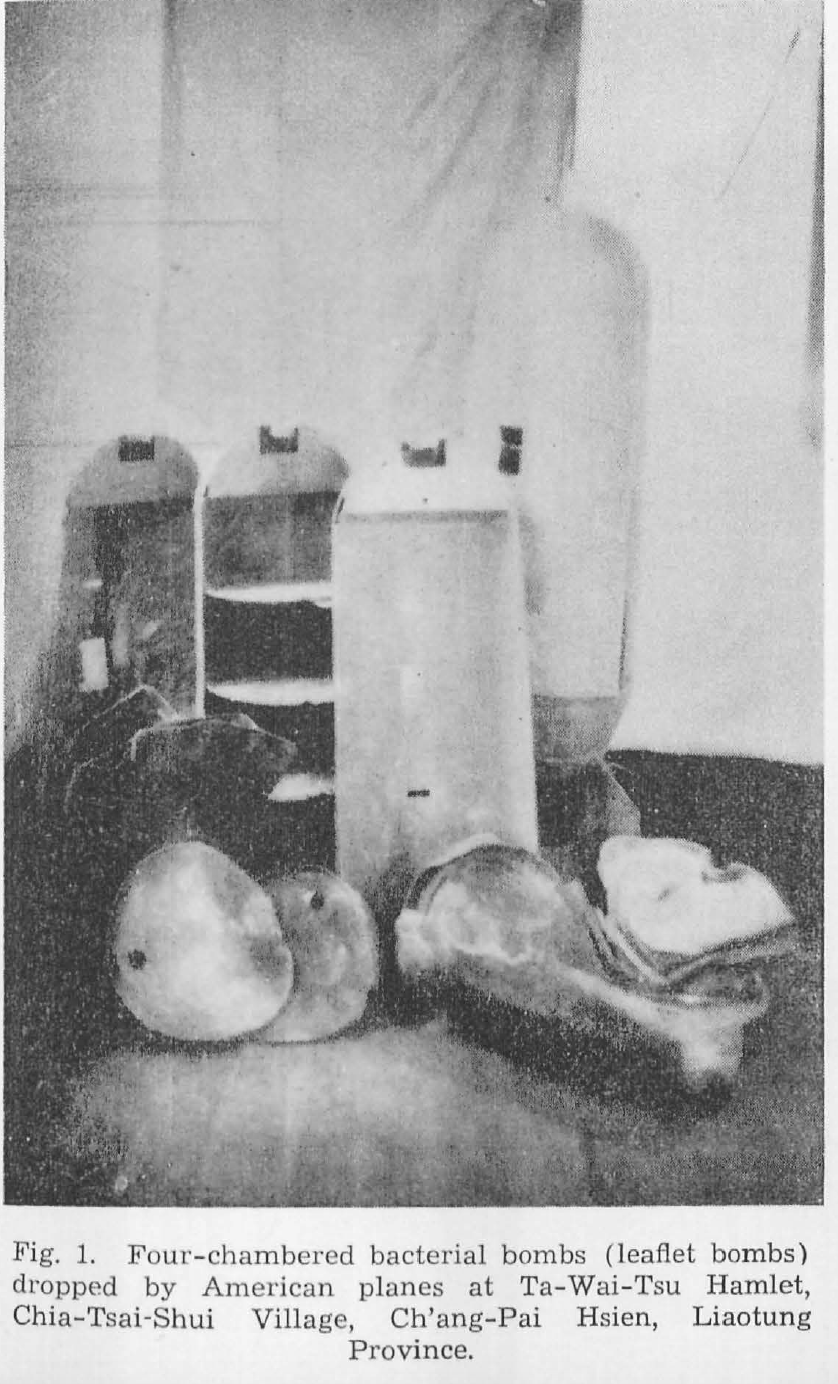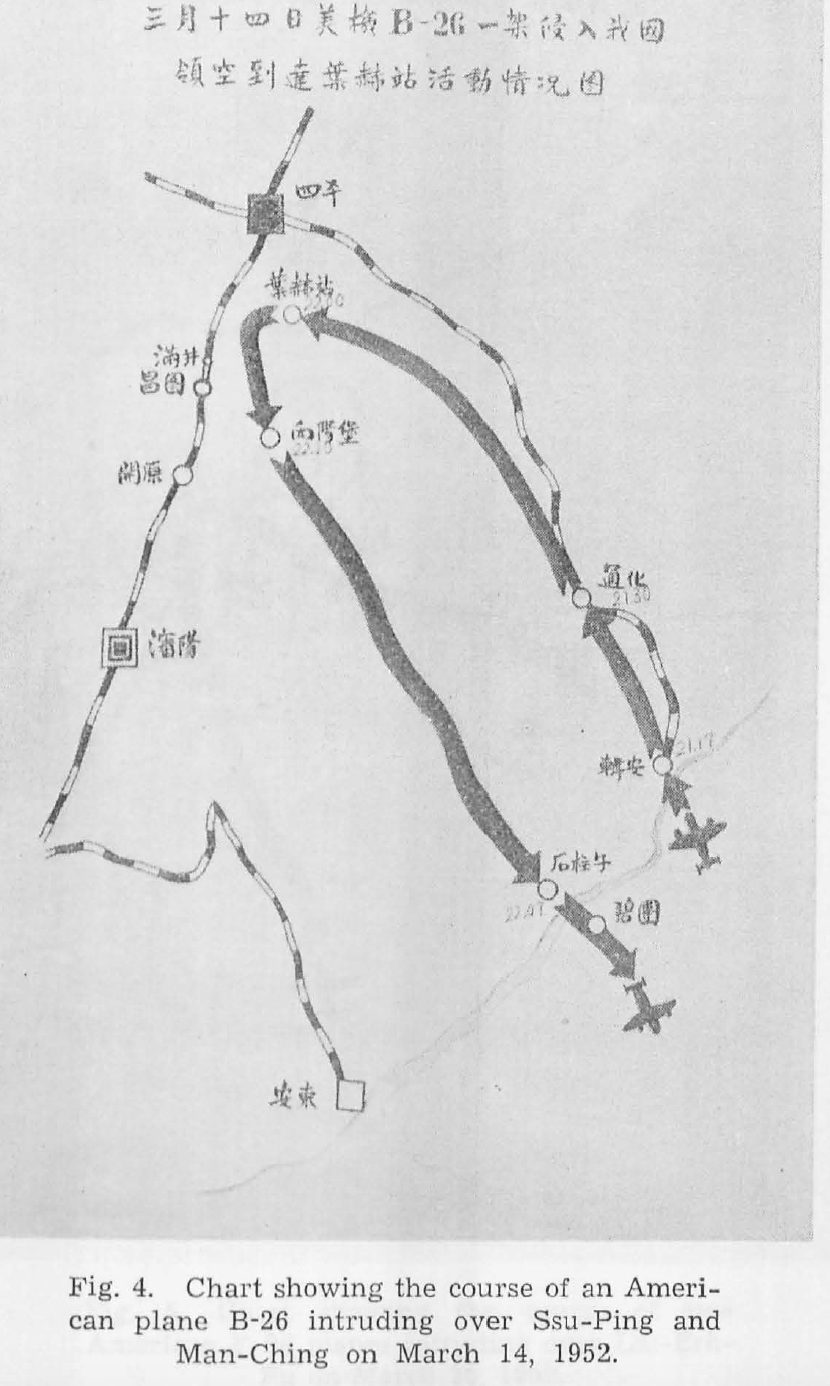Written largely by the most prestigious British scientist of his day, this official report, containing hundreds of pages of evidence about the use of US biological weapons during the Korean War, was effectively suppressed upon its original release in 1952.
Courtesy of researcher Jeffrey Kaye, INSURGE now publishes the report in text-searchable format for the first time for the general public, with an exclusive, in-depth analysis of its damning findings and implications.
The report provides compelling evidence of systematic violation of the laws of war against North Korea through the deployment of biological weapons — a critical context that is essential for anyone to understand the dynamics of current regional tensions, and what might be done about them.
/content/files/documents/4334133/isc-full-report-pub-copy.pdf
Back in the early 1950s, the U.S. conducted a furious bombing campaign during the Korean War, dropping hundreds of thousands of tons of ordnance, much of it napalm, on North Korea. The bombardment, worse than any country had received up to that point, excepting the effects of Hiroshima and Nagasaki, wiped out nearly every city in North Korea, contributing to well over a million civilian deaths. Because of the relentless bombing, the people were reduced to living in tunnels. Even the normally bellicose Gen. MacArthur claimed to find the devastation wreaked by the U.S. to be sickening.1
Most controversially, both North Korea and China alleged that by early 1952, the U.S. was using biological or germ warfare weapons against both North Korea and China. The U.S. government has strenuously denied this.
Nevertheless, captured U.S. flyers told their North Korean and Chinese captors about the use of such weapons. Later, after the prisoners were returned to U.S. custody, counterintelligence experts and psychiatrists interrogated them. They were told under the threat of court martial to renounce their confessions about germ warfare. They all did so.
The Army Criminal Investigative Division officer in charge of interrogating returning prisoners, including airmen who confessed to use of biological weaponry on North Korea and China, was Army counter-intelligence specialist, Col. Boris Pash. Pash had previously been in charge of security for the most sensitive classified operations of the U.S. government in World War II. He was in charge of security at the Manhattan Project’s Berkeley Radiation Laboratory. (The Manhattan Project was the U.S. crash program to develop the atomic bomb.)
In the immediate aftermath of the war, military intelligence officer Pash led the Alsos Mission, which searched for Nazi and Italian nuclear scientists and fissionable materials, as well as gathering “intelligence about any enemy scientific research applicable to his military effort,” including biological and chemical weapons. Later, Pash worked for the CIA, and in the 1970s was called before Congressional investigators concerning his alleged participation in Agency assassinations.2
To convince the world of the truth of their claim the U.S. had dropped biological weapons on their countries, and after turning down the suggestion that the International Red Cross look into the charges, the North Koreans and Chinese sponsored an investigating commission. Using the auspices of the World Peace Council, they gathered together a number of scientists from around the world, most of whom were sympathetic to either the Left or the peace movement. Most surprisingly, this commission, which came to be known as the International Scientific Commission, or ISC, was headed by one of the foremost British scientists of his time, Joseph Needham.
The ISC included scientists from a number of countries, including Sweden, France, Italy, and Brazil. The Soviet Union representative, Dr. N. N. Zhukov-Verezhnikov had been the chief medical expert at the Khabarovsk Trial of the Unit 731 Japanese officers accused of participating in bacteriological (aka biological, or germ) warfare before and during World War II, as well as conducting hideous experiments on prisoners to further that aim. Zhukov-Verezhnikov went on to write scientific articles through the 1970s.
Needham himself, though pilloried in the Western press for his opinions on the controversy of U.S. use of biological weapons during the Korean War, remained a highly lauded scientist for years after the ISC report. He was elected a fellow of the British Academy in 1971. In 1992, the Queen conferred on him the Companionship of Honour.3
The ISC travelled to China and North Korea in the summer of 1952 and by September produced the “Report of International Scientific Commission for the Investigation of the Facts Concerning Bacterial Warfare in Korea and China,” which corroborated the Chinese and North Korean claims that the U.S. had used biological weapons in an experimental fashion on civilian populations.
The summary report was only some 60 pages long, but the ISC included over 600 pages of documentary material comprising statements from witnesses, including airmen involved in dropping the weaponry, as well as captured enemy agents; reports from doctors; journal articles from the United States; autopsy reports and lab tests; and photos and other materials. Most of this documentary material has been all but inaccessible for decades, with only a handful of copies of the ISC report in a few scattered libraries in the United States.

The report concluded that the U.S. had used a number of biological weapons, including use of anthrax, plague, and cholera, disseminated by over a dozen of different devices or methods, including spraying, porcelain bombs, self-destroying paper containers with a paper parachute, and leaflet bombs, among others.
This article is not meant to examine the full range of opinions or evidence about whether or not the U.S. used biological weapons in the Korean War. It is instead an attempt to publish essential documentation of such claims, documentation that has effectively been withheld from the American people, and the West in general, for decades.
Controversies
The charges of U.S. use of biological warfare during the Korean War have long been the subject of intense controversy. The reliance, in part, on testimony from U.S. prisoners of war led to U.S. charges of “brainwashing.” These charges later became the basis of a cover story for covert CIA experimentation into use of use of drugs and other forms of coercive interrogation and torture that became the basis for its 1963 KUBARK manual on interrogation, and much later, a powerful influence on the CIA’s post-9/11 “enhanced interrogation” program.
Establishment Cold War scholars have been quick to debunk the ISC report. The most notable attempts in recent years included the publication of purported letters written by officials of the Soviet Union discussing the lack of evidence of U.S. biological warfare, and the decision to manufacture such evidence to fool the West.4 Subsequently, a 1997 memoir by Wu Zhili, the former director of the Chinese People’s Volunteer Army Health Division, was published declaring the purported U.S. use of bacteriological agents in the Korean War was really “a false alarm.”5
As two Canadian scholars who spent years researching the Chinese-North Korean claims of biological warfare have noted, if these documents were to be true, then it would go against the bulk of archival evidence, including interviews with pertinent witnesses in both the United States and China.6 Some of this archival evidence is quite recent, including the CIA declassification of a good deal of formerly top secret daily signal intelligence cables from the Korean War.7
The cables dealing with North Korean claims of biological warfare, which claims were dismissed by U.S. officials, prove that the North Koreans were serious about the belief they were being attacked by germ weapons, and that they were concerned that reports from the field not be falsified by assiduous if uninformed people sending in reports from the field. There is no evidence that North Korean officials or personnel ever engaged in falsification of evidence of biological warfare.
There also is plenty of archival evidence to be found in the suppressed Needham report materials. For instance, the Wu Zhili document claims, “‘for the entire year [1952–1953] no sick patient or deceased person was found to have anything to do with bacteriological warfare.”

But the ISC report documents a number of such deaths, including deaths from inhalational anthrax, a very rare disease almost completely unknown in China at that time. Appendix AA of the report, “Report on the Occurrence of Respiratory Anthrax and Haemorrhagic Anthrax Meningitis following the Intrusion of U.S. Military Planes over Northeast China” details the presence of anthrax by autopsy and laboratory examination in five deaths during March-April 1952. According to U.S. experts who have looked at the details of this report, the conclusions regarding death from inhalational anthrax could not have been faked.8
Until recently, there has been no effort to make the original Needham materials available for other scholars or the public to assess for themselves the truth or falsity of their analysis. Last year, scholar Milton Leitenberg uploaded a copy of the ISC report to Scribd, but it is a very rough scan, and not searchable, or easy to use for the public. The release was not advertised and the public in particular remains ignorant of its findings.
The version of the ISC report published here utilized state-of-the-art book scanning equipment and is text searchable.
Censorship of Unit 731-U.S. Collaboration on Biological Warfare Data
One important part of the ISC report guaranteed its suppression in the United States after its initial publication. The report discussed the activities of Imperial Japan’s biological warfare detachment, Unit 731, and the U.S. interest in its activities.
Back in 1952, collaboration between the U.S. and Japanese war criminals using biological weapons was top secret, and totally denied by the U.S.
But today, even U.S. historians accept that a deal was made between the U.S. and members of Unit 731 and associated portions of the Japanese military that had in fact been experimenting on the use of biological weapons since the mid-1930s, experimentation that included use of human vivisection and barbaric torture of thousands of human beings, most of whom were disposed of in crematoria. In addition, as described in the book chapter by Bernd Martin noted in the bibliography, there was collaboration between the Japanese and the Nazi regime on these issues.
The U.S. collaboration with Japanese war criminals of Unit 731 was formally admitted in 1999 by the U.S. government, though the documentation for this confession wasn’t published until nearly 20 years later.9
It is a matter of historical record now that the U.S. government granted amnesty to Japan’s chief at Unit 731, doctor/General Shiro Ishii and his accomplices. The amnesty was kept top secret for decades, until revealed by journalist John Powell in a landmark article for the Bulletin of Atomic Scientists in October 1981.
What came to be known as the Needham report, due to the fact the ISC was headed by the prestigious British scientist, came under immediate fire upon release. The report still remains a flashpoint for scholars. A 2001 article by the UK’s Historical Association detailed how UN and UK government officials collaborated in attempts to debunk the ISC findings. The UK Foreign Office released memoranda saying that claims of Japanese bacteriological warfare, going back to 1941, were “officially ‘not proven.’” (See article by Tom Buchanan in Bibliography.)
The sensitivity of the material uncovered by the ISC touched two areas of covert US government research. First was the US government’s own plans to research and possibly implement germ warfare. The second issue concerned the confessions of U.S. flyers as to how they were briefed and implemented trial runs of biological warfare during the Korean War.
China published the confessions of 19 U.S. airmen, but those confessions are also notoriously difficult to obtain. The ISC report published herein does include some of those “confessions,” and the public can be allowed to decide for themselves how authentic or genuine they are.

The U.S. claimed that the flyers were tortured, and the CIA promoted the idea they were “brainwashed” by diabolical methods, causing a scare about “commie” mind control programs and “menticide,” which they used to justify the expenditure of millions of dollars for U.S. mind control programs during the 1950s-1970s.
The programs, codenamed Bluebird, Artichoke, and MKULTRA, among others, used experiments on unwitting civilians, as well as soldiers undergoing supposed anti-torture training at the military’s SERE schools. I have shown via public records that CIA scientists continued to use experiments on “stress” at SERE schools after 9/11, and believe such research included experiments on CIA and/or DoD held detainees. That such research did take place can be inferred from the release in November 2011 of a new set of guidelines concerning DoD research. This newest version of a standard instruction (DoD Directive 3216.02) contained for the first time a specific prohibition against research done on detainees. (See section 7c.)
I believe a strong case can be made that while coercive methods, primarily isolation, was used on the U.S. prisoners of war who later confessed, that their confessions were primarily true. The idea that only false confessions result from torture is in fact false itself. While false confessions can result from torture (as well as less onerous methods, such as the Reid Technique, used by police departments throughout the United States today), actual confessions can also sometimes occur. I have first-hand experience working with torture survivors to know that is true.
Even so, it is a fact that all the POWs who confessed use of germ warfare later recanted that upon return to the United States. But the terms of their recantations are suspect. The recantations were made under threat of courts-martial, and after interrogations by U.S. counterintelligence agents and psychiatrists. The archival evidence of the flyers debriefings have been destroyed or lost due to fire (according to the government). Meanwhile at least one scientist working at Ft. Detrick at the time admitted to German documentary investigators before he died that the U.S. had indeed been involved in germ warfare in Korea. (See the documentary video, “Code Name: Artichoke.”10)
An “actual investigation… could do us psychological as well as military damage”
The charges of U.S. use of biological weapons during the Korean War are even more incendiary than the now-proven claims the U.S. amnestied Japanese military doctors and others working on biological weapons who experimented on human subjects, and ultimately killed thousands in operational uses of those weapons against China during the Sino-Japanese portion of World War Two. The amnesty was the price paid for U.S. military and intelligence researchers to get access to the trove of research, much of it via fatal human experiments, the Japanese had developed over years of studying and developing weapons for biological warfare.
During the Korean War, the U.S. strenuously denied charges of use of germ weapons and demanded an international investigation through the United Nations. The Chinese and North Koreans derided such offers, as it was United Nations-sanctioned forces that were opposing them in war and bombing their cities. But behind the scenes, the U.S. government initiated a campaign to impugn the ISC report, something they found difficult, as it turned out, according to a CIA-released document I revealed in December 2013. The document also showed the U.S. considered the call for a UN investigation to be mere propaganda.11
At a high-level meeting of intelligence and government officials on July 6, 1953, U.S. authorities admitted behind closed doors that the U.S. was not serious about conducting any investigation into such charges, despite what the government said publicly.
According to this document, the reason the U.S. didn’t want any investigation was because an “actual investigation” would reveal military operations, “which, if revealed, could do us psychological as well as military damage.” A “memorandum from the Psychological Strategy Board (PSB) detailing this meeting specifically stated as an example of what could be revealed “8th Army preparations or operations (e.g. chemical warfare).”12
Charges of chemical warfare by the Americans during the Korean War were part of a report by a Communist-influenced attorneys’ organization visiting Korea, and their findings were dismissed as propaganda by U.S. authorities and commentators. But the PSB memo suggests perhaps they were right.
Not long after I published the PSB document and accompanying article, scholar Stephen Endicott wrote to remind me that he and his associate Edward Hagerman, co-authors of the 1998 book, The United States and Biological Warfare: Secrets from the Early Cold War and Korea (see bibliography), had found material themselves that indicated U.S. calls for “international inspection to counter the Chinese and North Korean charges… was less than candid.”
Endicott and Hagerman found that U.S. Far East Commander, Gen. Matthew Ridgway, had “secretly given permission to deny potential Red Cross inspectors ‘access to any specific sources of information.’” In addition, they documented a State Department memo dated June 27, 1952 wherein the Department of Defense notified that it was “impossible” for the UN ambassador at the time to state that the U.S. did not intend to use “bacteriological warfare — even in Korea.” (p.192, Endicott and Hagerman)
The Khabarovsk War Crimes Trial
The ISC report also references the December 1949 war crimes trial held by the USSR in Khabarovsk, not far from the Chinese border. The trial of Japanese war criminals associated with Units 731, 100 and other biological warfare divisions followed upon a near black-out of such issues at the larger Toyko war crimes trials held by the Allies a few years before.
At the time of the Khabarovsk trial, U.S. media and government officials either ignored the proceedings, or denounced them as yet another Soviet “show trial.” The Soviets for their part published the proceedings and distributed them widely, including in English. Copies of this report are easier to find for purchase used, though expensive, on the Internet. Additionally, in the last few years Google made a copy of the former Soviet volume available online (see Bibliography). But no scholarly edition has ever been published.
Even so, U.S. historians have been forced over the years to accept the findings of the Khabarovsk court, though the general population and media accounts remain mostly ignorant such a trial ever took place. The fact the Soviets also documented the use of Japanese biological experiments on U.S. POWs was highly controversial, denied by the U.S. for decades, was a quite contentious issue in the 1980s-1990s. While a National Archives-linked historian has quietly determined such experiments did in fact take place, the issue has quietly fallen off the country’s radar. (See L. G. Goetz in bibliography.)
The relevancy of these issues is of course the ongoing propaganda war between the United States and North Korea, as well as Pentagon reallocation of resources to the Asian theater for a possible future war against China. But it is the clear threat of a nuclear exchange between North Korea and the United States that calls for clarity around the issues that have led to the mistrust between the two countries. Such clarity demands the release of all information that would help the U.S. populace understand the North Korean point of view. Such understanding, and acting upon such knowledge, may be all that separates us from a catastrophic war that could potentially kill millions of people.
The history behind the Korean War, and U.S. military and covert actions concerning China, Japan, and Korea, are a matter of near-total ignorance in the U.S. population. The charges of “brainwashing” of U.S. POWs, in an ongoing effort to hide evidence of U.S. biological warfare experiments and trials, also has become entwined in the propaganda used to explain the U.S. post-9/11 torture and interrogation program, and alibi past crimes by the CIA and Department of Defense for years of illegal mind control programs practiced as part of MKULTRA, MKSEARCH, ARTICHOKE, and other programs.
I hope that readers will feel free to disseminate this article without any copyright reservations, as well as the ISC report itself, an orphaned document from the Cold War.
Bibliography
Daniel Barenblatt, A Plague Upon Humanity: The Secret Genocide of Axis Japan’s Germ Warfare Operation, HarperPerennial, 2005
Tom Buchanan, “The Courage of Galileo: Joseph Needham and the ‘Germ Warfare’ Allegations in the Korean War,” The Historical Association, Blackwell Publishers, 2001
Dave Chaddock, This Must Be the Place: How the U.S. Waged Germ Warfare in the Korean War and Denied It Ever Since, Bennett and Hastings Publishers, 2013
Stephen Endicott & Edward Hagerman, The United States and Biological Warfare: Secrets from the Early Cold War and Korea, Indiana University Press, 1998
Stephen Endicott & Edward Hagerman, “Twelve Newly Released Soviet-era ‘Documents’ and allegations of U. S. germ warfare during the Korean War,” online publication, 1998, URL: http://www.yorku.ca/sendicot/12SovietDocuments.htm
Stephen Endicott & Edward Hagerman, “False Alarm? ‘The Bacteriological War of 1952’: Comment on Director Wu Zhili’s Essay,” online publication, June 1, 2016, URL: /content/files/sendicot/on-20wuzhili-false-alarm.pdf [accessed May 14, 2017]
Sheldon H. Harris, Factories of Death: Japanese Biological Warfare, 1932–45, and the American Cover-up, rev. ed., Routledge Press, 2002
Linda Goetz Holmes, Guests of the Emperor: The Secret History of Japan’s Mukden POW Camp, Naval Institute Press, June 2010.
Jeffrey Kaye, “CIA Document Suggests U.S. Lied About Biological, Chemical Weapon Use in the Korean War,” Shadowproof, Dec. 10, 2013, URL: https://shadowproof.com/2013/12/10/cia-document-suggests-u-s-lied-about-biological-chemical-weapon-use-in-the-korean-war/ (accessed February 21, 2018)
Materials on the Trial of Former Servicemen of the Japanese Army Charged With Manufacturing Bacteriological Weapons [Testimony and Exhibits from the Khabarovsk War Crimes Trial], Foreign Languages Publishing House, Moscow, 1950, published as free e-book at Google Books, URL: https://books.google.com/books?id=ARojAAAAMAAJ [accessed May 14, 2017]
Milton Leitenberg, “New Russian Evidence on the Korean War Biological Warfare Allegations: Background and Analysis,” Cold War International History Project, Bulletin 11, 1998
Milton Leitenberg, “China’s False Allegations of the Use of Biological Weapons by the United States during the Korean War,” CWIHP Working Paper #78
March 2016, URL: https://www.wilsoncenter.org/publication/chinas-false-allegations-the-use-biological-weapons-the-united-states-during-the-korean [accessed May 14, 2017]
Jeffrey A. Lockwood, Six-Legged Soldiers: Using Insects as Weapons of War, Oxford Univ. Press, 2010
Bernd Martin, “Japanese-German collaboration in the development of bacteriological and chemical weapons and the war in China,” in Japanese-German Relations, 1895–1945: War, Diplomacy and Public Opinion (Christian W. Spang, Rolf-Harald Wippich, eds.), Routledge, 2006
John Powell, “A Hidden Chapter in History,” Bulletin of the Atomic Scientists, October 1981
Peter Williams and David Wallace, Unit 731: The Japanese Army’s Secret of Secrets, Hodder & Stoughton, 1989 [Note: The U.S. version of this book, published by Free Press, does not include Chapter 17 on the Korean War, which is only available in the British Hodder & Stoughton version.]
-
Robert M. Neer, Napalm: An American Biography, 2013, Belknap Press, pg. 100. ↩
-
“Boris Pash and Science and Technology Intelligence,” Masters of the Intelligence Art series, U.S. Army Intelligence Center, Ft. Huachuca, undated. URL: http://huachuca-www.army.mil/files/History_MPASH.PDF (retrieved 1/20/2018)
In regards to Pash’s association with the CIA, we don’t know when his involvement with the Agency began, but it appears to have been quite early. Watergate defendant E. Howard Hunt told Congressional investigators in 1976 Pash was involved in assassination activities for the CIA during the 1960s. See “Executive Session, Saturday, January 10, 1976, United States Senate, Select Committee to Study Governmental Operations with Respect to Intelligence Activities, Washington, D.C.” URL: /content/files/wp-content/uploads/2015/12/1976-executive-session-hunt-testimony-on-pash.pdf (retrieved 1/20/2018) ↩ -
See URL: https://en.wikipedia.org/wiki/Joseph_Needham (retrieved 1/20/18). The article drew the information from Winchester, Simon (2008), The Man Who Loved China: The Fantastic Story of the Eccentric Scientist Who Unlocked the Mysteries of the Middle Kingdom. New York: HarperCollins. ↩
-
Leitenberg, Milton. (1998). Resolution of the Korean War Biological Warfare Allegations. Critical reviews in microbiology. 24. 169–94. 10.1080/10408419891294271. ↩
-
“Wu Zhili, ‘The Bacteriological War of 1952 is a False Alarm’,” September, 1997, History and Public Policy Program Digital Archive, Yanhuang chunqiu no. 11 (2013): 36–39. Translated by Drew Casey. https://digitalarchive.wilsoncenter.org/document/123080 ↩
-
“False Alarm? The Bacteriological War of 1952 — Comment on Director WuZhili’s Essay” by Stephen Endicott and Edward Hagerman, Department of History, York University (ret.), June 2016, /content/files/sendicot/on-20wuzhili-false-alarm.pdf ↩
-
“Baptism By Fire: CIA Analysis of the Korean War Overview,” URL: https://www.cia.gov/library/readingroom/collection/baptism-fire-cia-analysis-korean-war-overview ↩
-
For a full discussion, see “Updated: The Suppressed Report on 1952 U.S. Korean War Anthrax Attack,” https://valtinsblog.blogspot.com/2017/04/revealed-suppressed-report-on-1952-us.html ↩
-
Jeffrey S. Kaye, “Department of Justice Official Releases Letter Admitting U.S. Amnesty of Japan’s Unit 731 War Criminals,” Medium.com, May 14, 2017, URL: https://medium.com/@jeff_kaye/department-of-justice-official-releases-letter-admitting-u-s-amnesty-of-unit-731-war-criminals-9b7da41d8982 ↩
-
URL: http://topdocumentaryfilms.com/code-name-artichoke/ ↩
-
Jeffrey Kaye, “CIA Document Suggests U.S. Lied About Biological, Chemical Weapon Use in the Korean War,” Shadowproof, Dec. 10, 2013, URL: https://shadowproof.com/2013/12/10/cia-document-suggests-u-s-lied-about-biological-chemical-weapon-use-in-the-korean-war/# (accessed May 14, 2017) ↩
-
For the actual memorandum document, see URL: https://www.cia.gov/library/readingroom/docs/CIA-RDP80R01731R003300190004-6.pdf ↩








